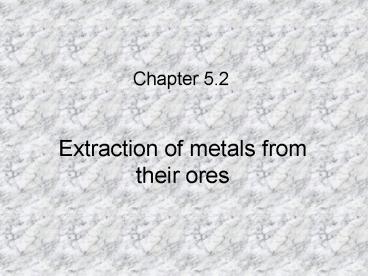Extraction of metals from their ores - PowerPoint PPT Presentation
1 / 15
Title:
Extraction of metals from their ores
Description:
Chapter 5.2 Extraction of metals from their ores An ore of a metal *metal *minerals *impurities Processes of obtaining a pure metal from an ore: Mining of the ... – PowerPoint PPT presentation
Number of Views:1377
Avg rating:3.0/5.0
Title: Extraction of metals from their ores
1
Chapter 5.2
- Extraction of metals from their ores
2
- An ore of a metal
- metal
- minerals
- impurities
3
Processes of obtaining a pure metal from an ore
- Mining of the ore
- Concentrating the ore
- Extraction of the metal from the concentrated ore
- Purification of the impure metal
-
(refer to pg. 89 )
4
EXAMPLES
- Iron(III) oxide carbon dioxide
- heat
- iron carbon dioxide
- 2. aluminium oxide
- electrolysis
- aluminium oxygen
-
(refer to p.90)
5
Limited reserves of natural resources
- Ores are limited in amount non-renewable.
- The supply will soon run out if we go on using
materials at the rate as at present. - We must use materials wisely.
- Natural resources can last longer.
-
(refer to pg.90)
6
Chapter 5.3
- Limestone, chalk and marble
7
Limestone, chalk marble
- Common rocks
- All contain the same mineral calcite
- calcite (a crystalline form of calcium
carbonate) - Different appearances
- Hardness differs
-
(pg. 90)
8
Limestone
- Most common form of calcium carbonate
- Hard strong, but inexpensive
- Used in building industry
-
(pg. 90)
9
Chalk
- Slightly softer than limestone
- Used in building
-
(pg. 90)
10
Marble
- Crystalline solid, very hard indeed
- Can be smoothly polished
- Used for statues, monuments, and as floors
walls in some buildings -
(pg. 90)
11
How were they formed?
- Remains of sea creatures having shells
- These built up a thick deposit one ocean beds
- Under great pressure turned into limestone or
- chalk.
- Mineral deposits were pushed upward and formed
hills -
(pg.91)
12
Similarities of limestone chalk
- Sedimentary rocks
- Often find the remains of sea creatures ( as
fossils) in limestone or chalk -
(pg.91)
13
How marble formed?
- Movement of earths crust bury limestone deep
underground - High temperatures very great pressures
- Limestone melted recrystallized to form marble
- Marble is metamorphic rock
-
(pg.91)
14
Use of limestone
- Used as a building material
- Make footpath
- Raw material for making cement
- Glass
- Steel
- Concrete
- Paper .. etc.
-
(pg.92)
15
END
- Thanks to you all































